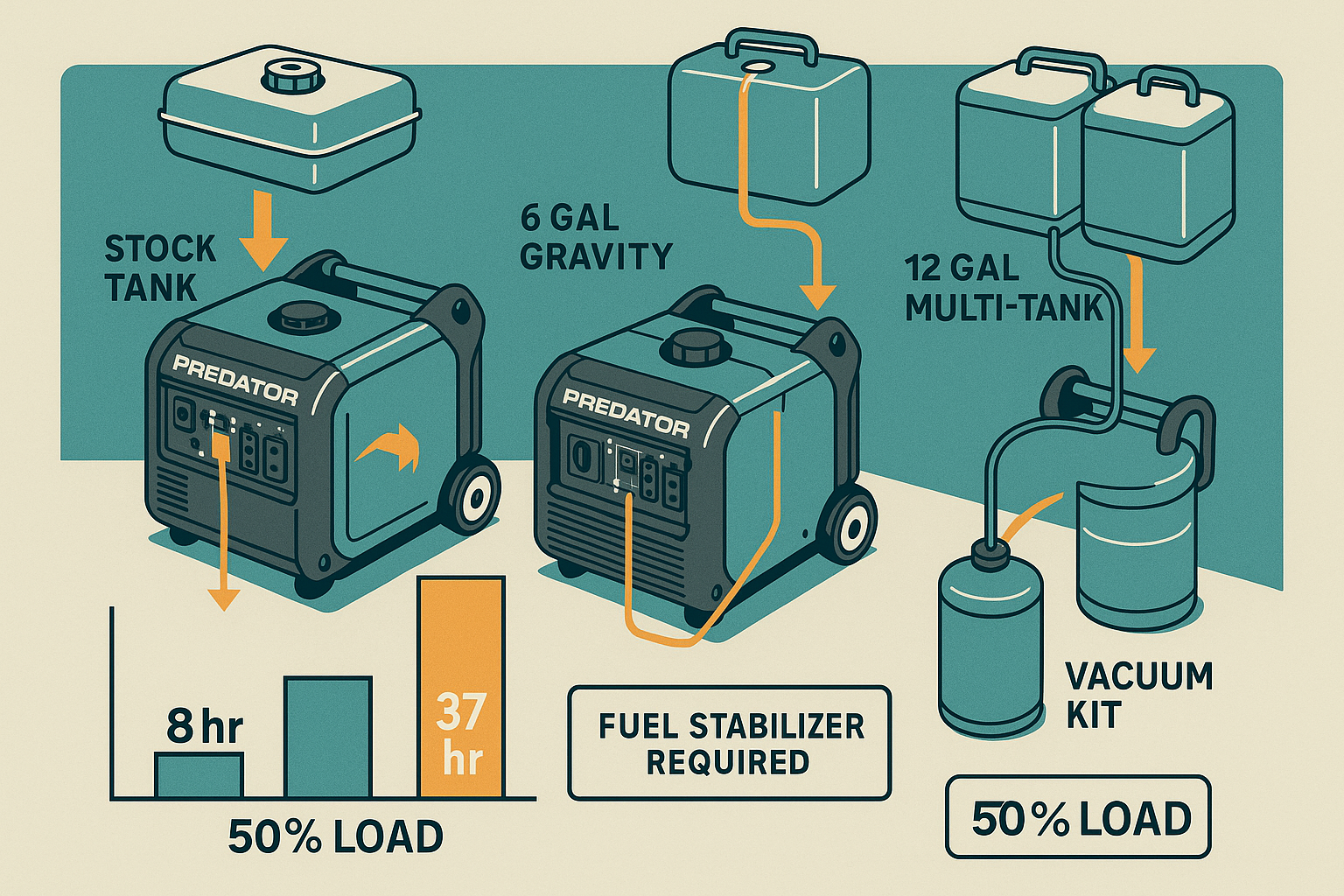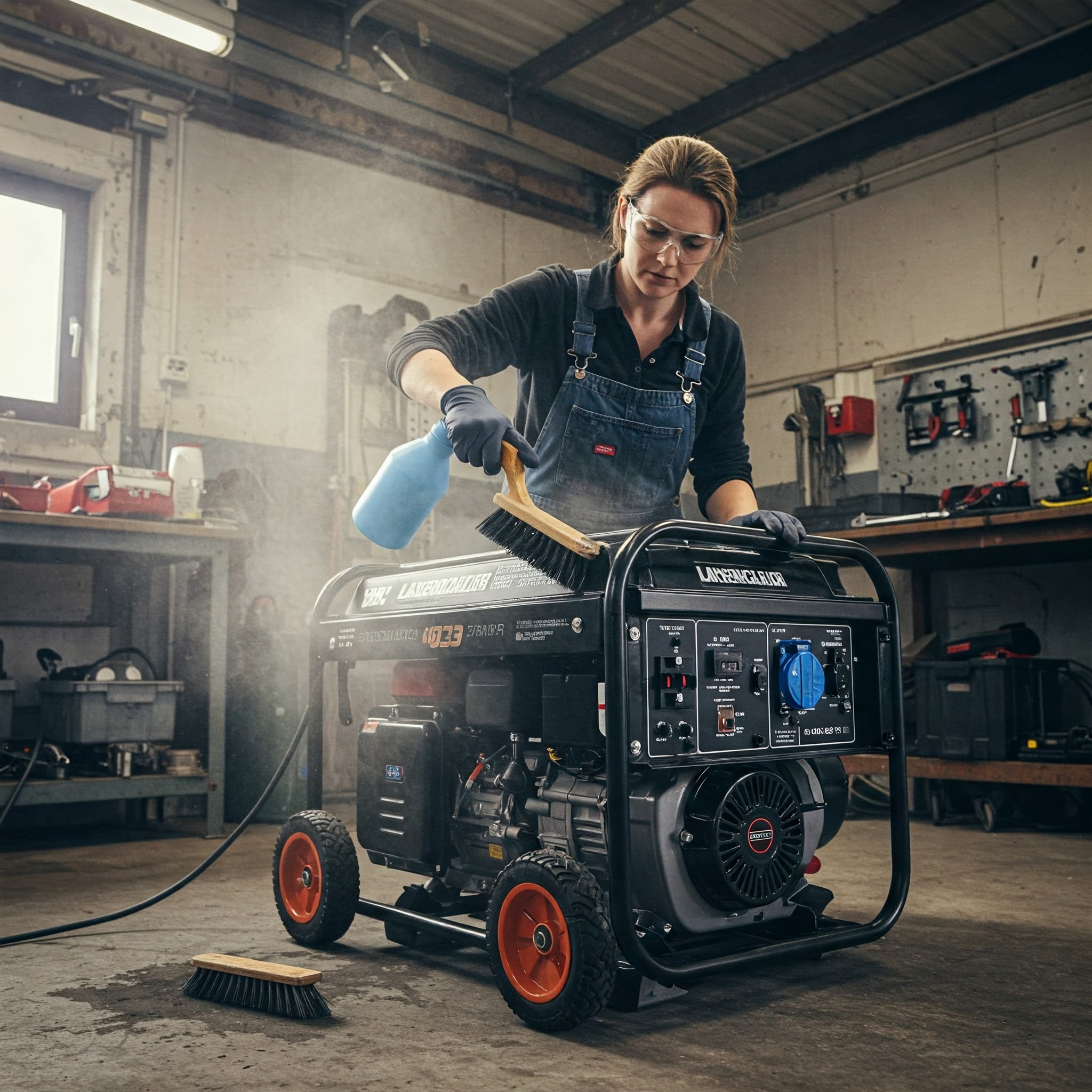Extending the Fuel Tank Capacity for Generators
When the power goes out — whether it’s due to a storm, a remote job site, or off-grid living — your portable generator is your lifeline. But if you’ve ever tried running one for more than a day, you know the biggest headache isn’t the noise or the cords… it’s refueling every few hours.
Most portable generators only run 5–11 hours before they need more gas, depending on how much power you’re pulling. That’s fine for a short outage. But what if you need 24, 48, even 72 hours of continuous power?
Good news: There are smart, proven ways to make your generator run longer, without constantly stopping to refill. In this guide, we’ll walk through everything from simple DIY hacks to advanced multi-tank systems — so you can choose the best option for your needs.
The Problem: Too Much Refueling, Not Enough Power
Let’s face it: refueling a generator during an outage is a pain. You have to stop using power, grab a gas can, pour fuel carefully (without spilling), and restart everything. And if you’re stuck in bad weather or working remotely, it’s not just inconvenient — it’s risky.
So why not let your generator run longer between refuels? With the right setup, you can go from hours of runtime to days — all with a few smart upgrades or DIY tricks.
Strategy #1: Add a Larger Fuel Tank to Your Generator
What Is It?
Instead of relying solely on your generator’s built-in fuel tank, you can physically attach a larger fuel tank to the generator itself. This increases your total fuel capacity and allows for longer operation.
Example:
- If your generator has a 2-gallon tank, adding another 2-gallon tank boosts your total capacity to 4 gallons.
- This could nearly double your runtime, especially under lighter loads.
Pros:
- Simple to install
- No complex equipment needed
- Immediate increase in runtime
Cons:
- Adds weight and size to the generator
- Reduces portability
- May void warranty if not manufacturer-approved
Strategy #2: Connect Multiple Fuel Tanks
What Is It?
You can connect multiple tanks together so the generator automatically switches from one tank to the next as fuel runs low. This method works well when you want long, uninterrupted power without manually switching tanks.
Example:
- If your generator has a 2-gallon tank, and you connect two more 2-gallon tanks, you now have 6 gallons of fuel available.
- As one tank empties, the system feeds from the next.
Pros:
- Allows for extended runtime
- Can be set up to auto-switch between tanks
- Great for emergencies or off-grid use
Cons:
- More complex setup
- Requires valves or special connectors
- May require some technical knowledge
Strategy #3: Use a Gravity-Fed Auxiliary Tank – Let Nature Do the Work
What Is It?
A gravity-fed system uses a second fuel tank placed above the generator. Thanks to gravity, fuel flows down into your generator automatically — no pumps or electricity needed.
Two Ways to Set It Up:
Buy a Kit (Commercial Option)
- Kits like the GenExtend Dual Tank System connect a 6–12 gallon tank to your generator.
- Comes with quick-connect fittings, special hoses, and a valve to switch between tanks.
- On a Predator 3500 generator, this can give you up to 50 hours of runtime at light load.
Build Your Own (DIY Option)
- Use old car tanks, metal drums, or jerry cans.
- Raise them on a stand or platform so they’re higher than the generator.
- Connect with safe fuel hose and a basic shut-off valve.
Pros:
- No electric parts = fewer things to break
- Cheap if you build it yourself (~$35)
- Simple to use once set up
Cons:
- Needs space to raise the tank
- Not easy to move around
- Limited by how big a tank you can lift safely
Strategy #4: Vacuum-Assisted Systems – Let the Engine Do the Work
What Is It?
Some modern inverter generators create a vacuum as they use up fuel. You can use that vacuum to suck fuel from a second tank automatically.
How to Do It:
Buy a Special Cap & Hose Setup
- Replace your generator’s fuel cap with one that has a vent and a hose connection (like the LWHwareHT kit).
- Attach a hose to a second tank — as the generator uses fuel, it pulls more from the extra tank.
DIY Hack
- Buy a brass hose connector and glue it into a modified fuel cap.
- Add a filtered pickup tube inside a jerry can to prevent dirt from getting into the engine.
- Seal everything tightly to avoid leaks.
Pros:
- Automatically refuels itself
- No extra power needed
- Keeps your generator portable
Cons:
- Only works on generators with sealed fuel systems
- Must use tanks that can handle vacuum pressure
- Risk of leaks or clogged filters if done wrong
Strategy #5: Multi-Tank Arrays – For Long Runs and Big Jobs
What Is It?
Connect multiple fuel tanks together using a central pipe system (called a manifold). This lets you feed fuel to one or more generators at once.
Two Options:
Smaller Kits for Home Use
- Kits like the HND1.2CD link two generators to one large tank.
- Great for camping or backup home power — gives you 12+ hours of uninterrupted power.
Industrial-Grade Solutions
- Companies like Western Global sell TransCube tanks that hold hundreds of gallons.
- Used on construction sites or emergency response setups.
- Features include built-in safety valves, GPS tracking, and forklift compatibility.
Pros:
- Can run generators for days without refueling
- Reduces trips to refill by up to 80%
- Good for teams or big events
Cons:
- More expensive ($140–$1,000+)
- Complex setup — may need tools and experience
- Not ideal for small-scale or personal use
Strategy #6: Use a Fuel Transfer Pump
What Is It?
A fuel transfer pump allows you to draw fuel from a larger external tank and pump it directly into your generator’s smaller fuel tank.
Example:
- If your generator has a 2-gallon tank, but you have a 5-gallon jerry can, a fuel pump lets you refill your generator on the fly without manual pouring.
Pros:
- Works with any size tank
- Easy to control fuel flow
- Useful for stationary setups
Cons:
- Requires electricity or battery to operate
- Adds cost and complexity
- Pumps can fail or leak
Strategy #7: Use a Fuel Tank Extension Hose
What Is It?
Some generators come with or can accept a fuel tank extension hose that allows you to connect directly to a larger external fuel source like a jerry can or drum.
Pros:
- Very simple setup
- No modifications required
- Easy to disconnect and store
Cons:
- May limit mobility
- Hose length restricts placement
- Some generators don’t support this feature
How Much Extra Time Will You Get?
Here’s a chart showing how adding bigger tanks boosts runtime on a popular generator — the Predator 3500:
| Tank Size | At 50% Load | At 25% Load |
|---|---|---|
| Stock (2.6 gal) | 8 hrs | 11 hrs |
| 6 gal | 18.5 hrs | 25 hrs |
| 9 gal | 27.5 hrs | 37.5 hrs |
| 12 gal | 37 hrs | 50 hrs |
So, doubling your fuel can almost quadruple your runtime — especially when you’re not using full power.
Important Things to Keep in Mind
Before you start modifying your generator, here are some key warnings and tips:
Warranty Issues
- Many manufacturers won’t honor warranties if you change the fuel system.
- For example, Honda says any damage from external tanks isn’t covered.
Safety Risks
- Some cheap kits or bad DIY setups can leak fuel, which is a fire hazard.
- Always double-check fittings and connections.
- Use fuel-safe hoses, proper seals, and never leave a running generator unattended.
Compatibility Tips
- Make sure your extra tank has the right size threads (usually 1/4″ NPT female).
- Use vented caps — otherwise, air can’t get in and fuel won’t flow properly.
- For large systems, add fuel stabilizers and filters to keep the fuel clean and fresh.
Choosing the Right Method: A Quick Guide
Here’s a step-by-step way to decide what’s best for you:
- What’s your budget?
- Low: Try a DIY gravity-fed setup
- Medium: Go for a vacuum-assisted system
- High: Invest in a multi-tank or industrial setup
- How long do you need to run the generator?
- Under 24 hours: Basic auxiliary tank
- 1–3 days: Vacuum-assisted or dual-tank
- Over 3 days: Multi-tank array or large external tank
- Do you need portability?
- Yes: Stick with gravity-fed or vacuum-assisted
- No: Multi-tank arrays are better for stationary use
Generator Fuel Extension Systems: Product Kits by Type
Here’s the system-specific breakdown with optimized quantities and essential notes:
1. Gravity-Fed System Kit
(Ideal for most portable generators without fuel pumps)
| Product | Quantity | Purpose |
|---|---|---|
| GenExtend Dual Tank Kit | 1 | Main valve/hose assembly |
| Scepter 5-Gal Fuel Can | 1-2 | Auxiliary tank (elevated) |
| Goldenrod 10 Micron Filter | 1 | Pre-filter for aux tank |
| Teflon Thread Seal Tape | 1 roll | Connection sealing |
| Total Runtime: 25-50 hrs (with 2 tanks) |
🌪️ 2. Vacuum-Assisted System Kit
(For inverter generators with fuel pumps – Honda/Yamaha/Predator)
| Product | Quantity | Purpose |
|---|---|---|
| LWHwareHT Vacuum Kit | 1 | Vented cap + hose + filter |
| RotopaX 3-Gal Tank | 1-2 | Mountable auxiliary tank |
| Permatex Aviation Sealant | 1 tube | Cap gasket sealing |
| Brass Hose Barb Fitting | 2 | DIY connection points |
| Total Runtime: 18-36 hrs (with 2 tanks) |
3. Multi-Tank Array System Kit
(For commercial/long-duration setups)
| Product | Quantity | Purpose |
|---|---|---|
| HND1.2CD Dual-Gen Kit | 1 | Dual generator manifold |
| Scepter 5-Gal Fuel Can | 3 | Primary fuel reservoir |
| TERA PUMP 12V Pump | 1 | Automated fuel transfer |
| Mr. Gasket Fuel Hose | 1 roll | Custom hose runs |
| Total Runtime: 36-72 hrs |
Universal Safety & Maintenance Items
(Required for ALL systems)
| Product | Quantity | Purpose |
|---|---|---|
| STA-BIL Fuel Stabilizer | 1 bottle | Prevents fuel degradation |
| Kidde Fire Extinguisher | 1 | Class B fire protection |
| Spill Containment Mat | 1-2 | Leak absorption/containment |
| Hose Clamp Assortment | 1 kit | Securing connections |
System Comparison Summary
| Feature | Gravity-Fed | Vacuum-Assisted | Multi-Tank |
|---|---|---|---|
| Best For | Occasional outages | Frequent mobile use | Job sites/cabins |
| Install Complexity | ★☆☆☆ (Easy) | ★★☆☆ (Moderate) | ★★★★ (Advanced) |
| Avg. Cost | $120-$180 | $90-$150 | $220-$350 |
| Refuel Interval | 24-48 hrs | 18-36 hrs | 48-72 hrs |
| Critical Tip | Tank must be 18″+ above generator | Requires functional fuel pump | Needs pump maintenance |
Universal Requirements:
- Test all systems with water before fuel use
- Replace fuel filters every 6 months
- Store stabilizer-treated fuel ≤ 30 days
Always consult generator manual before modification – improper setups may void warranties.
Balance Simplicity, Cost, and Safety
Extending your generator’s runtime doesn’t have to be complicated or expensive. Whether you go for a $35 DIY fix or spend hundreds on a commercial system, the key is to do it safely and reliably.
Key Safety Reminders:
- Vent all tanks to prevent vacuum lock
- Seal all connections to avoid fuel leaks
- Test your system with water first before using real fuel
- Always read your generator manual — even “universal” kits might not work perfectly
As one user learned the hard way:
“I thought this would save me time… but a failed gasket made me waste hours fixing it mid-storm.”
In short: Plan well, test carefully, and prioritize safety.


